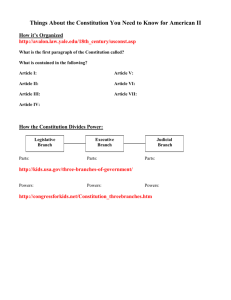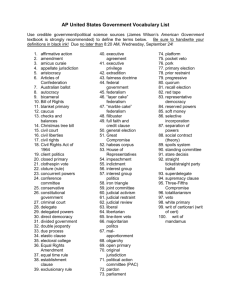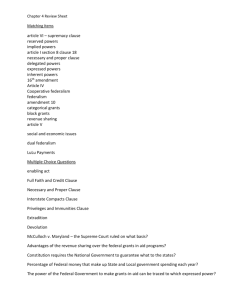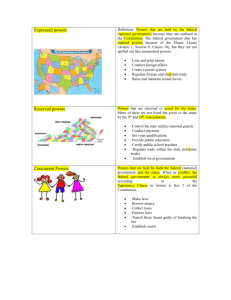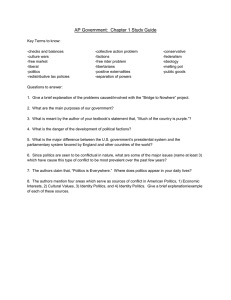dual federalism
advertisement
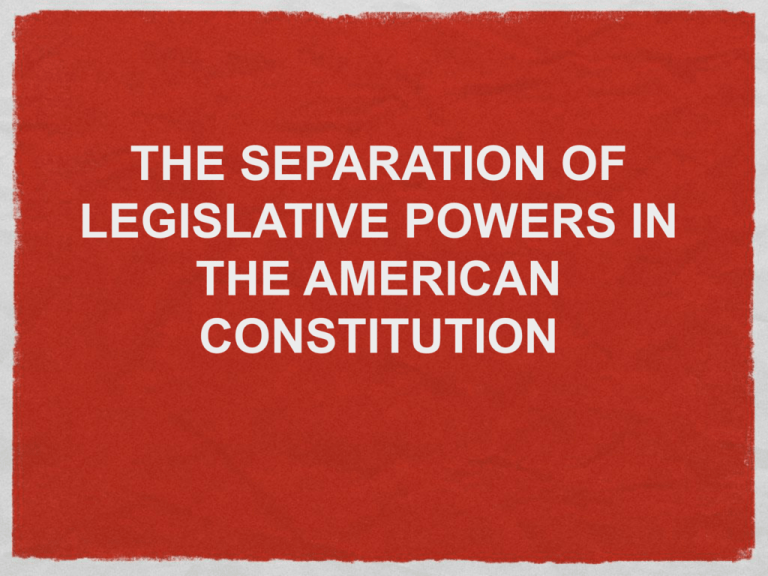
THE SEPARATION OF LEGISLATIVE POWERS IN THE AMERICAN CONSTITUTION CONSTITUTIONAL PROVISIONS ENUMERATED POWERS (ART. 1 SECT. 8) THE IMPLIED POWERS CLAUSE (ART. 1, SECT. 8 CLAUSE 18) THE RESIDUAL POWERS CLAUSE (X AMENDMENT) THE SUPREMACY CLAUSE (ART. 6 CLAUSE 2) DUAL FEDERALISM The federal Government has only enumerated powers The purposes that can be achieved by the federal Government are limited The federation and the states are, each in its own sphere, sovereign and equal The relationship between the two level of government are competitive (rather than cooperative) DUAL FEDERALISM “... although the State of Wisconsin is sovereign within its territorial limits to a certain extent, yet that sovereignty is limited and restricted by the Constitution of the United States. And the powers of the General Government, and of the State, although both exist and are exercised within the same territorial limits, are yet separate and distinct sovereignties, acting separately and independently of each other within their respective spheres.” (Ableman v. Booth, 1895) CIVIL WAR Defeats the idea that the the federal constitution is a pact between states (Calhoun > see introduction) Affirms the national theory > the federal constitution - establishing a dual system of government - has been created by an act of the people LIBERAL STATE > WELFARE STATE Second industrial revolution Federal legislation Interstate commerce act 1887 Sherman antitrust act 1890 Pure food and drug act 1906 XVI AMENDMENT “Representatives and direct taxes shall be apportioned among the several states ... according to their respective numbers” (Art. 1, sect. II par. 3) Pollock v. Farmers (1895) The Congress shall have the power to lay and collect taxes on incomes, from whatever source derived, without apportionment among the several states, and without regard to any census or enumerations (XVI am.) WELFARE AND DEMOCRATIC STATE “The Senate of the United States shall be composed of two Senators from each state, elected by the people ...” (XVII am.) “The right of citizens of the United States to vote shall not be denied or abridged by the United States or by any State on account of sex.” (XIX am.) THE NEW DEAL Economic crisis of 1929 F.D. Roosvelt presidency (1933-1945) • Agriculture Adjustment Act 1933 • National Recovery Act 1933 COOPERATIVE FEDERALISM national government and state one are complementary and they all tend to create a single government mechanism with the aim to fulfill the objectives fo the federal government in charge both levels pf government have some powers in any matters the border between federal and state jurisdictions is mobile and has to be defined by agreement between the two levels of government THE ROLE OF THE SUPREME COURT the court-packing crisis of 1937 centralization of powers by using the: commerce clause implied powers clause supremacy clause > pre-emption doctrine civil rights > Brown v. Board of Education grants in aid > coercive federalism NEW FEDERALISM to establish a clearer division of powers and responsibilities between federation and states and a consequent reduction of federal involvement in the activities of local interest to reduce the welfare state and the public intervention in citizens life to promote the individual (private) intervention in the welfare sector (school, health) to decrease the tax burden to introduce the deregulation program




